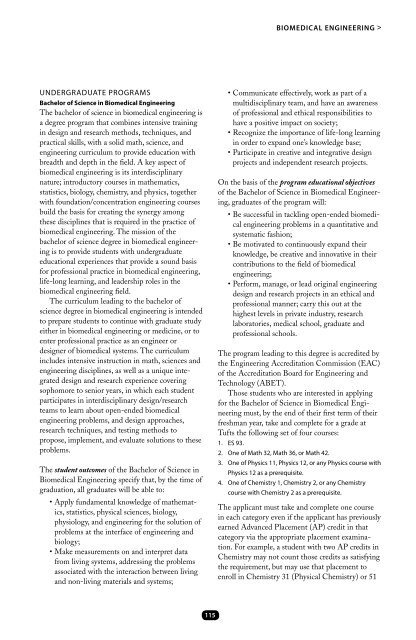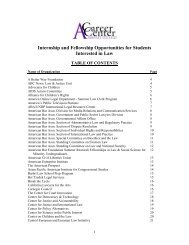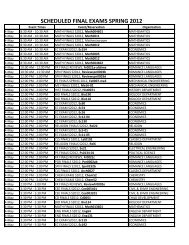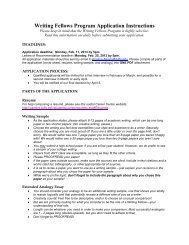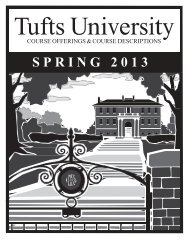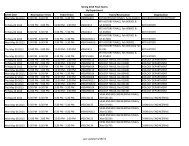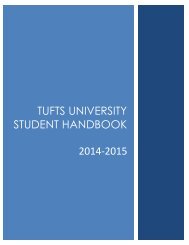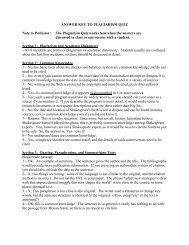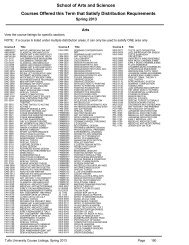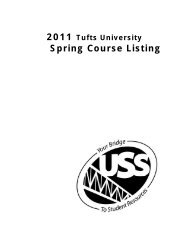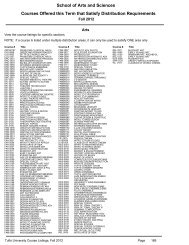2013â2014 The Bulletin - USS at Tufts - Tufts University
2013â2014 The Bulletin - USS at Tufts - Tufts University
2013â2014 The Bulletin - USS at Tufts - Tufts University
You also want an ePaper? Increase the reach of your titles
YUMPU automatically turns print PDFs into web optimized ePapers that Google loves.
Biomedical Engineering ><br />
UNDERGRADUATE ProgrAMS<br />
Bachelor of Science in Biomedical Engineering<br />
<strong>The</strong> bachelor of science in biomedical engineering is<br />
a degree program th<strong>at</strong> combines intensive training<br />
in design and research methods, techniques, and<br />
practical skills, with a solid m<strong>at</strong>h, science, and<br />
engineering curriculum to provide educ<strong>at</strong>ion with<br />
breadth and depth in the field. A key aspect of<br />
biomedical engineering is its interdisciplinary<br />
n<strong>at</strong>ure; introductory courses in m<strong>at</strong>hem<strong>at</strong>ics,<br />
st<strong>at</strong>istics, biology, chemistry, and physics, together<br />
with found<strong>at</strong>ion/concentr<strong>at</strong>ion engineering courses<br />
build the basis for cre<strong>at</strong>ing the synergy among<br />
these disciplines th<strong>at</strong> is required in the practice of<br />
biomedical engineering. <strong>The</strong> mission of the<br />
bachelor of science degree in biomedical engineering<br />
is to provide students with undergradu<strong>at</strong>e<br />
educ<strong>at</strong>ional experiences th<strong>at</strong> provide a sound basis<br />
for professional practice in biomedical engineering,<br />
life-long learning, and leadership roles in the<br />
biomedical engineering field.<br />
<strong>The</strong> curriculum leading to the bachelor of<br />
science degree in biomedical engineering is intended<br />
to prepare students to continue with gradu<strong>at</strong>e study<br />
either in biomedical engineering or medicine, or to<br />
enter professional practice as an engineer or<br />
designer of biomedical systems. <strong>The</strong> curriculum<br />
includes intensive instruction in m<strong>at</strong>h, sciences and<br />
engineering disciplines, as well as a unique integr<strong>at</strong>ed<br />
design and research experience covering<br />
sophomore to senior years, in which each student<br />
particip<strong>at</strong>es in interdisciplinary design/research<br />
teams to learn about open-ended biomedical<br />
engineering problems, and design approaches,<br />
research techniques, and testing methods to<br />
propose, implement, and evalu<strong>at</strong>e solutions to these<br />
problems.<br />
<strong>The</strong> student outcomes of the Bachelor of Science in<br />
Biomedical Engineering specify th<strong>at</strong>, by the time of<br />
gradu<strong>at</strong>ion, all gradu<strong>at</strong>es will be able to:<br />
• Apply fundamental knowledge of m<strong>at</strong>hem<strong>at</strong>ics,<br />
st<strong>at</strong>istics, physical sciences, biology,<br />
physiology, and engineering for the solution of<br />
problems <strong>at</strong> the interface of engineering and<br />
biology;<br />
• Make measurements on and interpret d<strong>at</strong>a<br />
from living systems, addressing the problems<br />
associ<strong>at</strong>ed with the interaction between living<br />
and non-living m<strong>at</strong>erials and systems;<br />
• Communic<strong>at</strong>e effectively, work as part of a<br />
multidisciplinary team, and have an awareness<br />
of professional and ethical responsibilities to<br />
have a positive impact on society;<br />
• Recognize the importance of life-long learning<br />
in order to expand one’s knowledge base;<br />
• Particip<strong>at</strong>e in cre<strong>at</strong>ive and integr<strong>at</strong>ive design<br />
projects and independent research projects.<br />
On the basis of the program educ<strong>at</strong>ional objectives<br />
of the Bachelor of Science in Biomedical Engineering,<br />
gradu<strong>at</strong>es of the program will:<br />
• Be successful in tackling open-ended biomedical<br />
engineering problems in a quantit<strong>at</strong>ive and<br />
system<strong>at</strong>ic fashion;<br />
• Be motiv<strong>at</strong>ed to continuously expand their<br />
knowledge, be cre<strong>at</strong>ive and innov<strong>at</strong>ive in their<br />
contributions to the field of biomedical<br />
engineering;<br />
• Perform, manage, or lead original engineering<br />
design and research projects in an ethical and<br />
professional manner; carry this out <strong>at</strong> the<br />
highest levels in priv<strong>at</strong>e industry, research<br />
labor<strong>at</strong>ories, medical school, gradu<strong>at</strong>e and<br />
professional schools.<br />
<strong>The</strong> program leading to this degree is accredited by<br />
the Engineering Accredit<strong>at</strong>ion Commission (EAC)<br />
of the Accredit<strong>at</strong>ion Board for Engineering and<br />
Technology (ABET).<br />
Those students who are interested in applying<br />
for the Bachelor of Science in Biomedical Engineering<br />
must, by the end of their first term of their<br />
freshman year, take and complete for a grade <strong>at</strong><br />
<strong>Tufts</strong> the following set of four courses:<br />
1. ES 93.<br />
2. one of M<strong>at</strong>h 32, M<strong>at</strong>h 36, or M<strong>at</strong>h 42.<br />
3. one of Physics 11, Physics 12, or any Physics course with<br />
Physics 12 as a prerequisite.<br />
4. one of Chemistry 1, Chemistry 2, or any Chemistry<br />
course with Chemistry 2 as a prerequisite.<br />
<strong>The</strong> applicant must take and complete one course<br />
in each c<strong>at</strong>egory even if the applicant has previously<br />
earned Advanced Placement (AP) credit in th<strong>at</strong><br />
c<strong>at</strong>egory via the appropri<strong>at</strong>e placement examin<strong>at</strong>ion.<br />
For example, a student with two AP credits in<br />
Chemistry may not count those credits as s<strong>at</strong>isfying<br />
the requirement, but may use th<strong>at</strong> placement to<br />
enroll in Chemistry 31 (Physical Chemistry) or 51<br />
115


